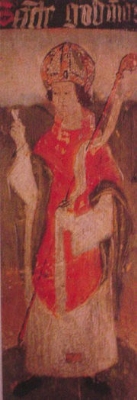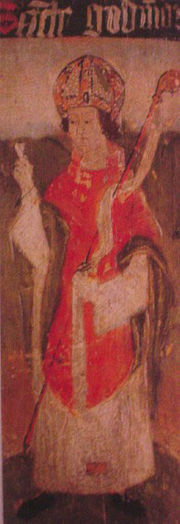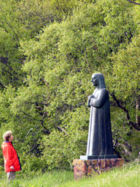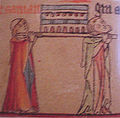
Guðmundur Arason
Encyclopedia

Iceland
Iceland , described as the Republic of Iceland, is a Nordic and European island country in the North Atlantic Ocean, on the Mid-Atlantic Ridge. Iceland also refers to the main island of the country, which contains almost all the population and almost all the land area. The country has a population...
ic saintly bishop
Bishop
A bishop is an ordained or consecrated member of the Christian clergy who is generally entrusted with a position of authority and oversight. Within the Catholic Church, Eastern Orthodox, Oriental Orthodox Churches, in the Assyrian Church of the East, in the Independent Catholic Churches, and in the...
who took part in increasing the powers of the Catholic Church in medieval Iceland
Iceland
Iceland , described as the Republic of Iceland, is a Nordic and European island country in the North Atlantic Ocean, on the Mid-Atlantic Ridge. Iceland also refers to the main island of the country, which contains almost all the population and almost all the land area. The country has a population...
. His story is recorded in several manuscripts, most notably Prestssaga Guðmundar góða. He is often referred to as Guðmundur góði (Gudmundr or Gudmund the Good)
Life
Guðmundur was born an illegitimate child in 1161, in Grjótá in Hörgárdalur, IcelandIceland
Iceland , described as the Republic of Iceland, is a Nordic and European island country in the North Atlantic Ocean, on the Mid-Atlantic Ridge. Iceland also refers to the main island of the country, which contains almost all the population and almost all the land area. The country has a population...
. He was ordained as priest in 1185 at the age of 24. A decade later, he had become one of the most influential clergymen in the Icelandic commonwealth
Icelandic Commonwealth
The Icelandic Commonwealth, Icelandic Free State, or Republic of Iceland was the state existing in Iceland between the establishment of the Althing in 930 and the pledge of fealty to the Norwegian king in 1262...
, culminating in his election as bishop of Hólar
Hólar
Hólar is a small community located in the Skagafjörður district and situated in northern Iceland.-Location:Hólar is located in the Hjaltadalur valley, some from the national capital at Reykjavík. Hólar has a population of around 100...
(the northern one of the two Icelandic bishop seats) in 1203.
He served for some time as house priest to Kolbeinn Tumason
Kolbeinn Tumason
Kolbeinn Tumason was a member of the Ásbirningar family clan, and was one of the most powerful chieftains in Iceland around the turn of the 12th century. His power was probably at its height around 1200 AD. Kolbeinn used his influence to ensure that men in his favour received positions of power...
, an Icelandic chieftain. In his years as a simple priest, he did not exhibit any interest in strengthening the Church as an institution, and did not seek wealth or other worldly goods. However, he acquired a reputation as pious and devout man, and even as a miracle-worker.
Upon his appointment as bishop, he was committed to continuing the work of his predecessors: namely, preserving the power structure of the Church. However, things quickly went awry. He was amongst the clerical visionaries who praised the virtue of poverty and believed the Church had been led astray by the acquisition of wealth. Both his contemporaries and later generations compared him with Thomas Becket
Thomas Becket
Thomas Becket was Archbishop of Canterbury from 1162 until his murder in 1170. He is venerated as a saint and martyr by both the Roman Catholic Church and the Anglican Communion...
. Guðmundur was generous with the Church's holdings, and soon a great number of impoverished dependents settled around Hólar
Hólar
Hólar is a small community located in the Skagafjörður district and situated in northern Iceland.-Location:Hólar is located in the Hjaltadalur valley, some from the national capital at Reykjavík. Hólar has a population of around 100...
. His generosity aroused the ire of local chieftains, and tensions escalated, leading to disputes concerning the judicial powers of the see. Guðmundur wanted the see to remain independent from the chieftains who had elected him, and made the first documented attempt in Iceland to maintain the judicial powers of the church over its own members.
Conflict with the chieftains

Kolbeinn Tumason
Kolbeinn Tumason was a member of the Ásbirningar family clan, and was one of the most powerful chieftains in Iceland around the turn of the 12th century. His power was probably at its height around 1200 AD. Kolbeinn used his influence to ensure that men in his favour received positions of power...
, chieftain of the Ásbirningar clan, had played an important part in Guðmundur's election, but in 1205 a dispute arose between the two. The cause of the dispute was a charge made by Kolbeinn against a priest who owed him money. According to church policy, the church had exclusive judicial powers in such matters. In the autumn of 1208, Kolbeinn travelled with a body of men to Hólar to carry out a sentence against a priest guilty of impregnating a woman. Kolbeinn's men clashed with the bishop's followers in what is known as Víðinesbardagi ("The Battle of Víðines") -- Kolbeinn and several of his men died in the conflict, which went in favour of the bishop. By 1209, Guðmundur's position was untenable and he was forced to flee the bishopry of Hólar.

Norway
Norway , officially the Kingdom of Norway, is a Nordic unitary constitutional monarchy whose territory comprises the western portion of the Scandinavian Peninsula, Jan Mayen, and the Arctic archipelago of Svalbard and Bouvet Island. Norway has a total area of and a population of about 4.9 million...
, by order of the archbishop, and when he returned home, he played things more delicately. Nevertheless, a large group of poor people were soon living on the Church's charity again. Arnór Tumason, the new leader of the Ásbirnings
Ásbirnings
The Ásbirnings were a powerful family clan in the medieval Icelandic Commonwealth. They dominated Skagafjörður in the 12th and 13th centuries until their last leader died in the Battle of Haugsnes in 1246. The Ásbirnings were well-known warriors and politicians. The best known Ásbirning is...
, travelled to Hólar and scattered the bishop's impoverished followers -- Guðmundur remained Arnór's captive for a year. He then travelled around Iceland for three years with his followers. Upon the death of Arnór, Tumi Sighvatsson rose to power in Skagafjörður
Skagafjörður
Skagafjörður is a deep bay in northern Iceland.-Location:Skagafjörður is about 40 km long and 15 km wide, situated between Tröllaskagi to the west and the Tjornes Peninsula to the east. There are two municipalities in the area, Skagafjörður Municipality and Akrahreppur Municipality Skagafjörður...
and claimed Hólar
Hólar
Hólar is a small community located in the Skagafjörður district and situated in northern Iceland.-Location:Hólar is located in the Hjaltadalur valley, some from the national capital at Reykjavík. Hólar has a population of around 100...
as his own. The bishop's men murdered Tumi in 1222 and Guðmundur was forced to flee to Grímsey
Grímsey
Grímsey is a small island in the country of Iceland, off the north coast of the main island of Iceland and straddling the Arctic Circle. In January 2011 it had 86 inhabitants....
, where he was intercepted and made a captive once again. Again, he was sent to Norway to face the archbishop's wrath. He returned to Iceland an old man, and played no significant further part in politics to his death in 1237.
Sainthood
The story of Guðmundur was very much to the Church's advantage. His disputes with the chieftains soon faded from collective memory, but his piety and generosity remained a legend. Within living memory, he was regarded as a holy man (or saint), and in 1315 his physical remains were interred in a grand ceremony. He thus became a sort of national saintSaint
A saint is a holy person. In various religions, saints are people who are believed to have exceptional holiness.In Christian usage, "saint" refers to any believer who is "in Christ", and in whom Christ dwells, whether in heaven or in earth...
, although the Roman Catholic Church
Roman Catholic Church
The Catholic Church, also known as the Roman Catholic Church, is the world's largest Christian church, with over a billion members. Led by the Pope, it defines its mission as spreading the gospel of Jesus Christ, administering the sacraments and exercising charity...
has to this day not acknowledged his sainthood. By the time a concerted effort was made to establish Guðmundr's sanctity in the first half of the fourteenth century, papal permission was necessary - and expensive.

